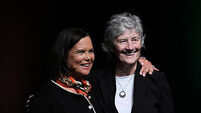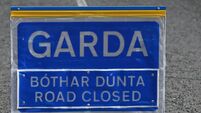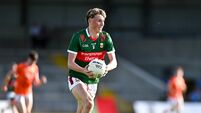Sophisticated system to elect leaders
THE Irish electorate will utilise one of the most sophisticated electoral systems in the world when choosing the TDs who will represent the country in the 31st Dáil.
While the vast majority of voters have only a rudimentary knowledge of the intricacies of PR — Proportional Representation, it has been used in varying grades of cunning and refinement by the Irish electorate to achieve the result they required.
PR is enshrined in the Constitution. Article 16, section 2.4 states: ‘‘The members shall be elected on the system of proportional representation by means of the single transferable vote.’’ The Constitution also decrees the smallest number of TDs that can be elected from any constituency is three.
There have been two failed attempts to alter this provision but the Irish electorate has taken PR to its heart and will be very slow to abandon it.
The principles of PR were formulated systematically in the middle of the 19th century by CCG Andrae in Denmark and Thomas Hare and John Stuart Mill in Great Britain. Since then, several methods for applying it have been devised; the best known are the single-transferrable-vote method and the list system.
The best way to explain how PR works in the Irish context is to take an example of an election result. One of best remembered Irish election counts was the 1987 General Election in the three-seat North Kerry constituency. The then Tánaiste Dick Spring held his seat, after a recount, by just four votes from Fianna Fáil’s Tom McEllistrim.
The magic word in an Irish election is “quota” — any candidate who reaches the quota is elected. The quota is calculated utilising a simple but ingenious mathematical formula, the so-called Droop formula (named after its deviser, the Belgian HR Droop). The total number of valid votes cast is divided by the number of seats to be filled plus one, and one is added to the result, to give you the quota.
This makes it possible for only the number of seats allocated to any given constituency to be filled.
In 1987 there was a 76.9% poll in the three-seat North Kerry constituency with 35,061 of the electorate of 45,602 casting a vote. There were 299 spoiled votes to leave a total valid poll of 34,762.
To calculate the quota the total valid poll of 34,762 is then divided by the number of seats (3) + 1 = 4, ie 34,762 ÷ 4 = 8690.25, disregarding the fraction .25 and adding one gives the quota of 8,691. In three-seat constituencies like North and South Kerry a good rule of thumb is — 25% of the vote plus one vote is a quota.
In 1987 Fine Gael’s Jimmy Deenihan topped the poll with 10,087, Denis Foley (FF) was next on 7,611, Dick Spring (Lab) polled 6,737, Tom McEllistrim (FF) got 6,161, Dan Kiely (FF) polled 2,939, D Finucane (SF) 668 and D Leen (SF) 559.
As Jimmy Deenihan exceeded the quota by 1,396 votes he was deemed elected on the first count.
On quick analysis Fianna Fáil had 48% of the poll, 2% short of two quotas, while Spring was on 19.4% — 5.6% short of a quota. Spring was in real trouble.
The second count was the distribution of Jimmy Deenihan’s surplus of 1,396. The destination of these votes was determined by examining all of Jimmy Deenihan’s 10,087 votes.
Counting staff under the direction of returning officer, the late Louise McDonough, physically arranged all the ballot papers on which Deenihan had received a number one into new bundles. The second preference of each ballot paper dictated into which “sub parcel” of votes it was transferred with each remaining candidate have a “sub-parcel”.
Deenihan’s 1,396 votes were then divided proportionally between the remaining candidates based on the percentage of number twos they received from Deenihan’s number one votes. The non-transferable votes (plumpers) were also put into their own parcel.
It is interesting to note that all votes in a surplus situation are passed on to the remaining candidates on a percentage basis. The non-transferable votes are not used when making the calculations.
On examining all of Deenihan’s 10,087 number ones, Dick Spring received 58.52% of the number two votes and was then allocated that percentage of Deenihan’s surplus, ie 817.
The result of the second count was: Foley 7,778 (+166); Spring 7,555 (+817); McEllistrim 6,293 (+132); Kiely 3,119 (+180); Finucane 752 (+84); Leen 576 (+17).
The third and fourth counts were the distribution of Sinn Féin candidates Leen and Finucane’s 1,637 votes. This was simple examination of their number twos plus the lower preference of the actual ballot papers transferred from Deenihan’s surplus to their bundles. Legislation passed in 1992 permits the elimination of two candidates on the one count.
However, this distribution did not alter the strength of the candidates and the fifth count was the distribution of Kiely’s vote, now grown to 3,370, among the three remaining candidates Foley, Spring and McEllistrim.
After Kiely’s votes were distributed the result was: Foley 9,619 (+1,500); Spring 8,309 (+486); McEllistrim 7,522 (+1,073).
Foley was now 925 votes over the quota and the final count was the distribution of these votes between Spring and McEllistrim.
Spring was 787 votes ahead but their were 925 votes to be distributed. However, the distribution of a candidates surplus in later counts varies from the manner in which surpluses are transferred after a first count.
In this case the last bundle to arrive to Foley are used to determine where the surplus votes should go. This bundle was the 1,500 Kiely number twos which put Foley over the quota.
Now Kiely’s number threes came into play and while the internal FF allegiance was highly commendable, 92.3% of Foley’s surplus went to McEllistrim. The 7.7% which went to Dick Spring kept him ahead of McEllistrim by just four votes — after a recount. Before the recount Spring was five votes ahead.
This exercise shows voters should and often do indicate as many preferences as possible on the ballot paper.













